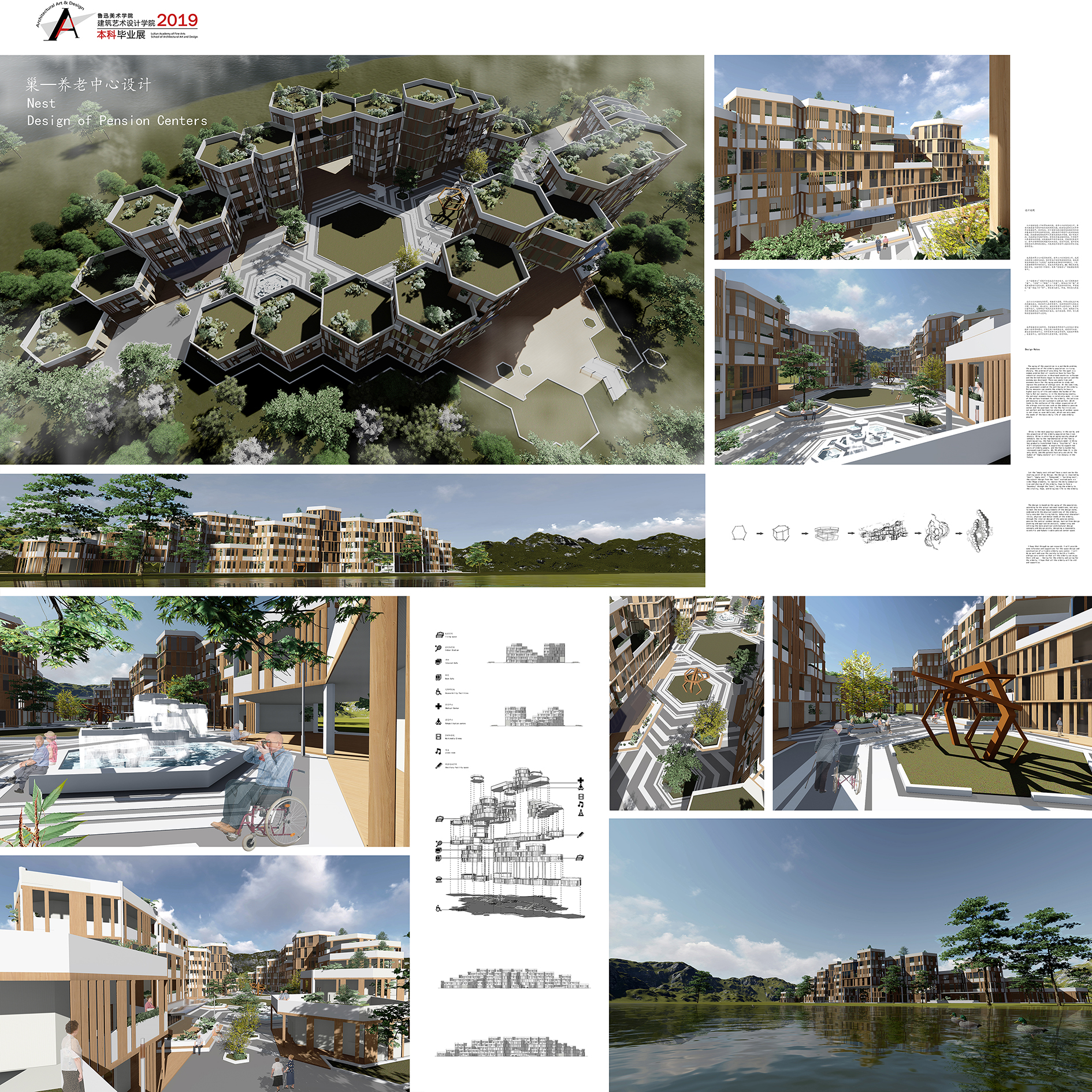设计说明
人口老龄化是一个世界性的问题,老年人口比例急剧上升,养老问题是各个国家所要共同面对的问题。欧美发达国家工业革命开始发展较早,经济发达,对于老龄化的问题有充裕的时间和经济基础去研究并改善养老问题,同时政府针对老年人良好的福利待遇、政策措施能够使老年人有着较高的生活质量,减少家庭负担。而我国处于发展中国家,国家经济基础相对薄弱,针对老年人养老的福利待遇、政策措施都不够系统完善,导致国内养老中心、老年公寓等养老机构室内组织混乱,设施不完善,室外空间功能规划不清晰甚至匮乏,只能满足部分老年人基本日常生活起居的需求。
我国是世界上人口最多的国家,老年人口比例急剧上升,我国正提前进入老龄化社会。由于实施计划生育政策的原因,使我国家庭结构模式从“大家庭”逐渐转化成为4-2-1结构模式,一对夫妻要赡养照料两对老人,家庭负担明显增大。80、90后家里是独生子女,父母只有一个孩子,未来“空巢老人”的数量会急剧攀升。
让“空巢老人”有巢可归是我设计的出发点,设计灵感来源于“巢”,“空巢”—“蜂巢”—“筑巢”,整体设计由“巢”演变出纯粹的六边形元素,提高老人日常交流性和共享性,希望通过“巢”构成一个“界”,带给老人朝气、希望,带给老人新生。
设计以人口老龄化为背景,根据实际国情,不单以满足设计规范的最低要求,结合老年人的身体条件,充分考虑老年人的生活习惯、行为特征、身心需求,通过对养老中心室内设计,养老中心室外设计,无障碍设计规划及应用等分析、总结、提炼出了较为实用的建筑设计理念和设计要点,设计出合理、科学、有人情味的宜居性养老中心空间。
我希望通过自己的研究,为宜居性老年养老中心空间设计建设提供一些参考和建议,尽自己的一份绵薄之力,同时呼吁社会,建设宜居性养老中心,令所有老年人能安享晚年。关爱老年群体,关爱老年人,愿所有老年人老有所养,老有所依。
Design Notes
The aging of the population is a worldwide problem, the proportion of the elderly population is rising sharply, the problem of providing for the aged is a common problem that all countries have to face.The industrial revolution in developed countries in Europe and the United States began to develop earlier and the economy was developed. There was ample time and economic basis for the aging problem to study and improve the problem of old-age care. At the same time, the government aimed at the well-being of the elderly. Policy measures can enable the elderly to have a higher quality of life and reduce the burden of the family.But our country is in the developing country, the national economic base is relatively weak, in view of the welfare treatment for the elderly, the policies and measures are not systematic and perfect, which leads to the confusion of the indoor organization of the old-age institutions such as the domestic pension center and the apartment for the The facilities are not perfect and the function planning of outdoor space is not clear or even deficient, which can only meet the needs of the basic daily life of some elderly people.
China is the most populous country in the world, and the proportion of the elderly population has risen sharply. China is entering an aging society ahead of schedule. Due to the implementation of the family planning policy, the family structure model in China has gradually transformed from a “big family” to a 4-2-1 structure model. A couple has to support two pairs of elderly people, and the family burden has increased significantly. 80, 90 after home It is the only child, and the parents have only one child. The number of "empty nesters" will rise sharply in the future.
Let the "empty nest old man" have a nest can be the starting point of my design, the design is inspired by "nest", "empty nest" - "honeycomb" - "building nest", the overall design from the "nest" evolved pure six sides Shape elements, to improve the daily communication and sharing of the elderly, hope to form a "boundary" through the "nest", bring the elderly to the vitality, hope, and bring new life to the elderly.
The design is based on the aging of the population, according to the actual national conditions, not only to meet the minimum requirements of the design norms, combined with the physical conditions of the elderly, fully consider the living habits, behavioral characteristics, physical and mental needs of the elderly, through the interior design of the pension center, pension The central outdoor design, barrier-free design planning and application analysis, summarizing and refining the more practical architectural design concepts and design points, designing a reasonable, scientific and humane livable pension center space.
I hope that through my own research, I will provide some reference and suggestions for the space design and construction of a livable elderly care center. I will do my part and urge the society to build a livable old-age care center so that all the elderly can enjoy their old age. . Caring for the elderly and caring for the elderly, I hope that all the elderly will be old and supportive.
